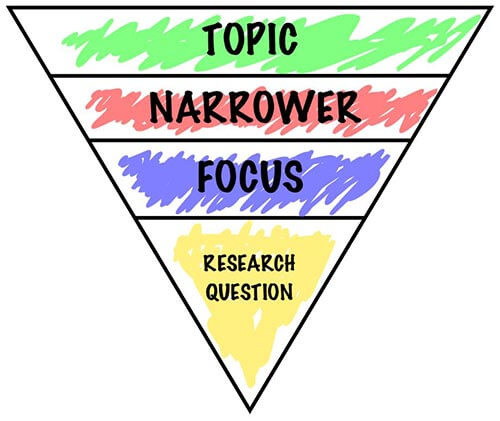Chapter 5: Asking Research Questions
Developing Your Research Question
Because of all their influence, you might worry that research questions are difficult to develop. Sometimes it can seem that way. But you’ll get the hang of it and, luckily, none of us has to come up with an incredible question right away. Remember, it’s a process! That’s why we talk about developing research questions instead of just writing them.
Steps for Developing a Research Question
The steps for developing a research question, listed below, can help you organize your thoughts.
Step 1: Pick a topic (or consider the one assigned to you).
Step 2: Write a narrower/smaller topic that is related to the first.
Step 3: List some potential questions that could logically be asked in relation to the narrow topic.
Step 4: Pick the question that you are most interested in.
Step 5: Revise the question you’re interested in so that it is more focused.

Practice
Once you know the steps and their order, only three skills are involved in developing a research question:
- Imagining narrower topics about a larger one,
- Thinking of questions that stem from a narrow topic, and
- Revising questions to be more specific or focused.
Every time you use these skills, it’s important to evaluate what you have produced—that’s just part of the process of turning rough drafts into more finished products.
Developing a Research Question
For each of the narrow topics below, think of a research question that is logically related to that topic. (Remember that good research questions often, but not always, start with “Why” or “How” because questions that begin that way usually require more analysis.) After you have written your question, click on the topic to see the questions we came up with.
Topics:
After you think of each research question, evaluate it by asking whether it:
| 1. Is not easily answered with a simple yes or a no (or a hasty google search) | It has some substance and requires explanation. |
| 2. Has an underlying problem with social significance (local, national or international) | It is important to someone other than just you! |
| 3. Poses a genuine question and aims for neutrality | It avoids using loaded language or suggesting a predetermined answer. |
| 4. Can be answered with reliable evidence | It is researchable. Others have already been contributing to this conversation. |
| 5. Has appropriate scope | It is not too narrow, nor too broad; it doesn’t leave you with too much or too little information. |
Sometimes the first draft of a research question is still too broad, which can make your search for sources more challenging. Refining your question to remove vagueness or to target a specific aspect of the topic can help.
Focusing Questions
The first draft research questions below are not focused enough. Read them and revise them to eliminate vagueness and increase focus. We’ve included some potential revisions, but yours might be even stronger!
First Drafts of Research Questions:
Adaptations
Material in this section has been adapted from Developing Your Research Question in Choosing & Using Sources: A Guide to Academic Research by Teaching & Learning, Ohio State University Libraries, licensed under a Creative Commons Attribution 4.0 International License, except where otherwise noted.
Media Attributions
- process © storyset is licensed under a CC BY (Attribution) license
- Research-Question-Example-Write-1 © Chad Flinn is licensed under a CC BY (Attribution) license
- evaluate © storyset is licensed under a CC BY (Attribution) license



